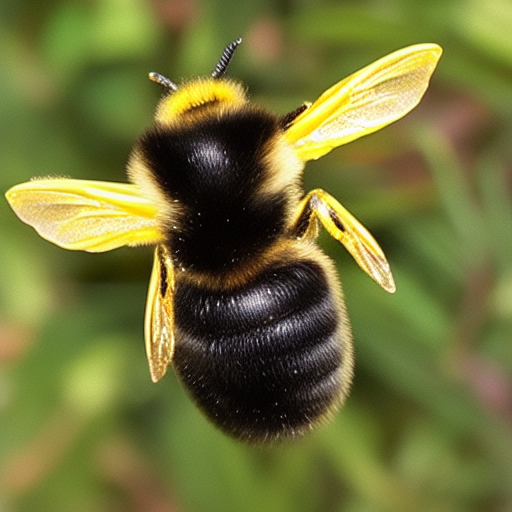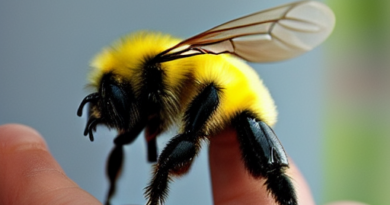Do Bumble Bees Have Stingers? Unveiling the Fascinating World of Bumble Bee Defenses
Introduction
Bumble bees are a remarkable species of insects that play a crucial role in maintaining biodiversity by pollinating plants. These chubby, fuzzy creatures are known for their distinctive appearance and gentle nature, making them a favorite among nature enthusiasts. However, their docile demeanor doesn’t mean they lack defenses. Let’s explore the intricate details of bumble bee stingers and their defensive strategies.
Do Bumble Bees Have Stingers?
Yes, bumble bees do have stingers. Similar to their close relatives, honey bees, bumble bees are equipped with stingers that can deliver a painful sting if they feel threatened. Unlike honey bees, bumble bee stingers are not barbed, which means they can sting multiple times without injuring themselves. This key distinction sets bumble bees apart in the realm of stinging insects.

The Anatomy of a Bumble Bee Sting
A bumble bee’s stinger is a modified ovipositor, an organ primarily used by female insects to lay eggs. However, in the case of bumble bees, the stinger has evolved into a defensive tool. When a bumble bee feels threatened or perceives its nest to be in danger, it can use its stinger to inject venom into the intruder. This venom, while not usually life-threatening to humans (unless allergic), can cause localized pain, swelling, and discomfort.
See Also: Do Bumble Bees Sting? And What You Can Do About It
How Do Bumble Bee Stingers Differ from Honey Bee Stingers?
While both bumble bees and honey bees possess stingers, the key difference lies in the design. Honey bee stingers have barbs that get lodged in the victim’s skin upon stinging, often leading to the death of the honey bee as it attempts to escape. On the other hand, bumble bee stingers lack barbs, enabling them to sting multiple times without detachment. This crucial distinction makes bumble bees less likely to die after stinging.
The Sting: When and Why?
Bumble bees are not aggressive by nature and typically sting only when they perceive a direct threat to themselves or their colony. They are more likely to sting if their nest is disturbed, or if they feel cornered or crushed. Interestingly, male bumble bees, or drones, lack stingers altogether, so the stinging behavior is predominantly observed in female worker bees and queen bees.

The Intricate Dance of Bumble Bee Behavior
Understanding bumble bee behavior is crucial to avoid unintentional encounters that could lead to stings. Bumble bees, unlike some more aggressive species, are generally docile and focused on their important pollination duties. They’re often seen buzzing around flowers, collecting nectar and pollen to feed their colony. However, if their nests are disturbed or if they perceive a threat, their behavior can change.
Recognizing Defensive Postures
To avoid accidental stings, it’s helpful to recognize certain defensive postures that bumble bees might exhibit. If a bumble bee perceives you as a threat, it might raise its front legs in the air while lowering its head, a stance that signifies it’s ready to sting. Additionally, loud and sudden movements can startle these bees, potentially triggering a defensive response.
The Importance of Avoidance
Preventing bee stings largely revolves around practicing caution and avoidance. When you encounter bumble bees, especially near their nests, try to remain calm and move away slowly. It’s important to note that bumble bees are not out to sting humans; they’re merely protecting themselves or their nests when they feel threatened. Respect their space, and you’ll greatly reduce the chances of getting stung.

Bee Sting Myths Debunked
There are numerous myths surrounding bee stings, often causing unnecessary fear. Let’s debunk some common misconceptions:
Myth: All Bees Sting Repeatedly
As we’ve learned, bumble bees can sting multiple times due to their lack of barbed stingers. However, not all bee species possess this capability. Honey bees, for instance, can only sting once before their stingers become detached, leading to their unfortunate demise.
Myth: Bumble Bees Seek Out Humans to Sting
Bumble bees are not naturally aggressive towards humans. They have no intention of seeking out people to sting. Stings typically occur when they feel threatened, cornered, or when their nests are disturbed.
Myth: Allergic Reactions Are Immediate
While many people are allergic to bee stings, not all reactions are immediate or severe. Allergic responses can vary widely, ranging from mild localized reactions to more serious systemic symptoms. It’s essential to monitor your reaction and seek medical attention if you experience difficulty breathing or other severe symptoms.
Buzzing with Positivity: Bumble Bees and Biodiversity
Beyond the occasional sting, bumble bees are essential contributors to our ecosystems. Their role in pollination ensures the reproduction of numerous plant species, including many that provide us with fruits, vegetables, and nuts. The decline of bee populations worldwide is a cause for concern, as it could impact our food supply and the health of our environment.
As you observe these remarkable creatures buzzing around your garden, remember that their presence signifies a healthy ecosystem. Creating pollinator-friendly spaces with diverse flowers and nesting sites can help support bumble bees and other pollinators, ultimately benefiting both nature and humans.
Embracing Nature’s Fuzzy Wonders: Bumble Bee Appreciation
The presence of bumble bees in our surroundings is a reminder of the intricate web of life that sustains us all. Their distinctive appearance, gentle demeanor, and vital role in pollination make them a fascinating subject of study and admiration. So, next time you spot a bumble bee buzzing among the flowers, take a moment to appreciate the beauty and significance of this tiny yet mighty creature.

FAQs
Are bumble bee stings dangerous? Bumble bee stings are usually not dangerous unless the individual is allergic to bee venom. For most people, a bumble bee sting will cause localized pain, swelling, and itching, but the symptoms subside within a few hours or days.
Can bumble bees sting multiple times? Yes, bumble bees can sting multiple times without dying. Unlike honey bee stingers, which detach upon stinging, bumble bee stingers are smooth and can be withdrawn without harm.
Do all bumble bees have stingers? No, male bumble bees (drones) do not have stingers. Only female bumble bees, both workers and queens, are equipped with stingers for defense.
What should I do if I get stung by a bumble bee? If you get stung, immediately remove the stinger if it’s lodged in your skin. Clean the area with soap and water, and apply a cold pack to reduce swelling. Over-the-counter pain relievers and antihistamines can help alleviate discomfort.
Are bumble bees beneficial despite their stingers? Absolutely! Bumble bees are crucial pollinators that contribute to the reproduction of numerous plant species, including many of the crops we rely on for food. Their role in ecosystems far outweighs the rare instances of stinging.
How can I avoid getting stung by bumble bees? To avoid getting stung, stay calm and avoid sudden movements around bumble bees. Steer clear of their nests, and if you encounter one up close, slowly and gently move away from it.
Conclusion
Bumble bees, with their adorable appearance and vital ecological role, indeed have stingers. These stingers are not only a tool for defense but also a reminder of the intricate ways insects have adapted to their environments. As you observe these remarkable creatures in nature, remember that while their stingers might seem intimidating, they play an essential part in the delicate balance of our ecosystems.
Enjoyed this article? You may also like:
Do Bumble Bees Sting? And What You Can Do About It
Do bees have knees? Facts Behind Bees Knees
Does Febreze kill Ants? Things You Need to Know
Do Ants Poop? The Fascinating answer to one of nature’s most puzzling questions!




